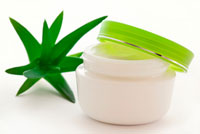|
 Aloe vera has been used for medicinal purposes in several cultures for millennia, and is a popular modern ingredient in many topical skin care products for its moisturizing and wound healing abilities.1 Believed to possess anti-inflammatory and antibacterial properties, aloe is believed to act as a natural antiseptic as well, possessing the ability to penetrate deep into all three layers of the skin to promote healing.2 Aloe vera has been used for medicinal purposes in several cultures for millennia, and is a popular modern ingredient in many topical skin care products for its moisturizing and wound healing abilities.1 Believed to possess anti-inflammatory and antibacterial properties, aloe is believed to act as a natural antiseptic as well, possessing the ability to penetrate deep into all three layers of the skin to promote healing.2
All of these properties suggest that aloe may also be an effective treatment for acne, but clinical test results are mixed. One study found that up to 90% of skin breakouts could be healed within five days when using a topical application of the gel—twice as effective as standard acne ointments.2 There have also been some in vitro and animal studies that corroborate aloe’s anti-inflammatory reputation, and one of aloe’s bioactive constituents is known to have immuno-modulatory properties.3 Aloe gel was shown to inhibit expression of inflammatory proteins induced by human immune cells exposed to bacteria.3
However, in an experiment to test the inhibitory effects of different anti-inflammatory substances against Propionibacterium acnes (P. acnes), aloe exhibited negligible to no activity. Evidence shows that P. acnes plays a role in the development of acne by promoting the production of both free radicals and pro-inflammatory proteins. Aloe had no impact on the production of free radicals, and showed insignificant suppression of inflammatory factors.4
It may be that aloe’s role in acne therapy is as a companion to other therapies. Evidence supports its wound-healing abilities, and an older clinical study demonstrated that aloe accelerated healing in patients who had full-face dermabrasion to treat severe acne.5
More recently results from a clinical trial involving 94 college students with acne demonstrated that aloe significantly improves the acne-healing benefits of 2% Ocimum oil. While employing aloe alone produced no benefit, the Ocimum oil and undiluted or 50% aloe combination proved more effective than antibiotic treatment with 1% Clindamycin in reducing the number of inflammatory acne lesions.6
Some holistic medical centers use aloe’s anti-inflammatory properties to treat skin conditions. Dr. Deepak Chopra recommends two ounces of aloe juice with four ounces of carrot juice for teens with acne, and a topical aloe gel to help heal acne lesions.7 Practitioners of Traditional Chinese Medicine recommend massaging slices of fresh aloe vera leaves onto acne lesions, but caution to stop using if an allergic skin reaction develops.8
In Ayurveda medicine, aloe is believed to exert cooling and detoxifying effects. Aloe is typically used to treat excessive Pitta, but balances all three doshas.7
|